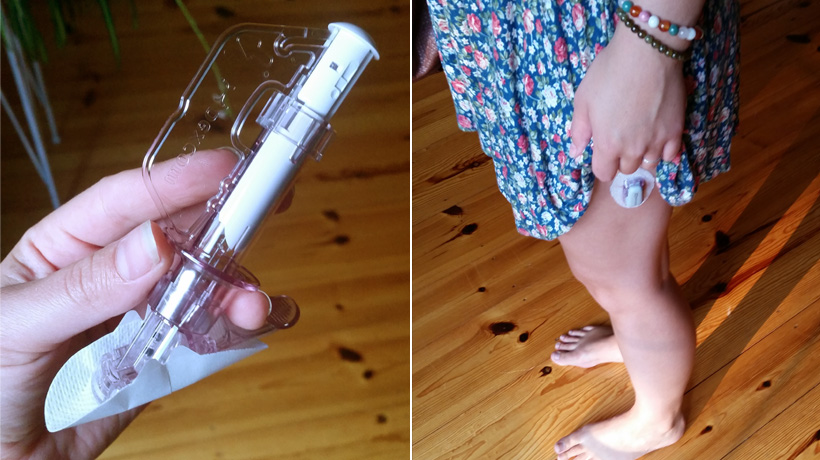Learn the common reasons for CGM inaccuracies so that you can improve your Libre or Dexcom’s accuracy. Because an accurate CGM leads to better sugar control, which leads to less roller coasters and more stability; and who doesn’t want that?!
12 reasons for CGM inaccuracies
CGMs are an AMAZING tool for diabetes management, but that tool is only amazing when it’s accurate. I get so sad when I see people giving up on their CGM too quickly because they got off to a bad start. While most of the time it works great, there are times when it’s off.

1. It’s a Lemon
Just chalk this one up to bad luck. You got a lemon. Just like any piece of technology or machinery there are instances where it’s just got bad robot parts. Whether it’s a faulty sensor, transmitter, or receiver, it’s just junk. That’s okay tho! Freestyle and Dexcom are excellent at replacing sensors or transmitters at no cost and shipping it to you overnight – or ground depending on your supply.
2. Location
Some people find that their CGM is more accurate on certain parts of their body than others. This could be for a few reasons including how close to a muscle the sensor is, the quality of interstitial fluid in that area, or the amount of scar tissue in that area. The longer you have a CGM the more you’ll learn which parts of your body work the best.
3. It’s Coming Loose
Check your site. Is the bandage lifting up or coming loose? If it is, that’s probably why your readings are off. Every time that sensor slides in and out of your body, due to the adhesive coming loose, it has the potential to throw off your readings. If this happens to you it’s an easy fix: tape that sucker down! Here are some other ways to get your CGM to stay put!
4. Too Close to a Muscle
Typically when the sensor is too close to a muscle or near the fascia layer surrounding a muscle it will give you erratic readings (usually a false low). For me, this is especially true when I sleep on it. This phenomenon is known as a compression low.
5. Compression Low
A compression low is when your Freestyle Libre, Dexcom, or any CGM is compressed, usually pushing close to a muscle, and giving you a false reading of a low. If this happens, roll over and your CGM will balance back out.
6. Dehydration
Dehydration affects the circulation in your interstitial fluid; which is the fluid that the sensor reads. If you’re getting inaccurate readings, try drinking some water and hydrating yourself.
7. Exercise
Exercise can temporarily throw off your CGM readings because the glucose in that area (where your CGM is) might be burning off more glucose than the rest of the body. For example, if your Freestyle Libre, Dexcom, or other CGM is on your quad and it’s leg day, you may get inaccurate readings
8. Too Close To Your Insulin Pump
The intestinal fluids in an area where insulin is being delivered will be different than the intestinal fluid where insulin is not directly being delivered. Most CGM companies like Dexcom and the Freestyle Libre don’t recommend putting your CGM close to your insulin pump, or injection site, for this very reason. They consider close to be within a few inches. However, I myself have never experienced this, and sometimes my CGM and pump are just an inch away from each other. But, if this happens to you and you’re getting weird readings, just add some space next time.
9. Certain Medication Can Throw Off CGM Readings
Certain medications will mess with your interstitial fluids, which is the fluid your CGM reads.
Acetaminophen (Tylenol) or any drug containing paracetamol are notorious for causing false highs. If this happens to you, ignore your sensor readings for the next 8-10 hours and just use finger sticks (blood readings).
10. A Blood Sugar Roller Coaster
Interstitial fluids naturally lag 5 minutes behind blood sugar. If you’re having wild BG swings 5 minutes could be the difference of 10-50pts! If this is happening to you just know that your CGM will catch up once your BG takes a chill pill.
11. You Got a Bleeder
You’ve struck gold! If you insert your CGM and get a bleeder it could either mean you’re about to get really accurate readings or some not-so-accurate readings – I’ve encountered both.
12. Inaccurate Calibration (only applies to CGMs that take calibrations)
There are a few rules to calibrating your CGM if you want to get the most accurate readings.
- Make sure you have clean fingers! Giving your CGM an inaccurate BG reading because you still had cookie crumbs on your finger will totally throw off your readings. Make sure you’re always calibrating with clean fingers.
- Don’t calibrate with straight up or straight down arrows. These arrows indicate rapidly changing Dexcom readings. It’s best to wait until your BG levels out a bit and the arrows are gone (like in point #10). A diagonal pointing arrow is ok to calibrate with.
Have You Run Into Reasons for CGM Inaccuracies?
Let me know, in the comments below, if you’ve experienced CGM inaccuracies. Or if you have tips/tricks that help with accuracy.
 Please share this list of Reasons for CGM Inaccuracies with someone who uses a CGM like Dexcom or Abbotts FreeStyle Libre. Sharing helps more people find this blog. Thank you!
Please share this list of Reasons for CGM Inaccuracies with someone who uses a CGM like Dexcom or Abbotts FreeStyle Libre. Sharing helps more people find this blog. Thank you!
If you’re interested in learning more about the Freestyle Libre or Dexcom click on their links.




also, Dexcom will replace a sensor that doesn’t stay on for it’s appointed days (7,10, etc.).
yes! love that about dexcom
compression lows are the worst! so many false alarms. I had to start putting dex on my calf because i kept sleeping on it when it was on my arm and thigh. Now the calf is my favorite spot!
same! I love the calf for my libre
Thanks for the info and tips! Just a comment for any Medtronic users – they are also wonderful at replacing sensors quickly, with no questions asked besides the lot number.
When my Dexcom G6 suddenly says my BG is hurtling down, like to 60 and below, I know something’s wrong with the CGM, not me. So I do a stick, get my real BG number, and try to recalibrate via the pump and my phone. I often have to put the correct BG in twice before it accepts the calibration. Not sure why.
Libre 2
When i sleep (no compression), or inactive my readings will be low ( 10- 30).
Get up move about and it normalizes quickly.
Thanks, my wife has been using her first CGM ( Libre 3) for nearly 3 months. We have experienced several of the problems that you explained. Have tried to talk to the co representatives several times (difficult because of strong accents) but were not very helpful. None of your solutions were suggested.
I has been very helpful in identifying foods she is sensitive to.
Libre has been very good in replacing sensors that appeared to be out of range.
Hi, and thank you for the helpful info. I’m trying to find out if it’s common to have unexpected/abnormally high readings (with a straight up arrow) following time in a hot tub. Even though Abbott says the Libre can be underwater for up to 30 minutes, I still keep my arm out of the water. So it is never submerged, but of course it doesn’t stay completely dry either. When I get out, readings will be as much as 55-70 points higher than when I started. Has anyone else experienced this with your CGM readings?
Maybe the warmer water is an issue?
Can my CGM be affected by the nerve stimulator that is implanted in my back even though it is inserted on the opposite side of my body? My CGM and BGM are usually very different, many times over 50 points. If I eat based on the number displayed on my CGM, my numbers shoot up rapidly. The inaccuracies I have experienced are causing me to question whether it is right for me. Do you have insight to share?
My sister is using a Medtronic guardian 4 sensor with her 780g insulin pump. The sensors never last more than 5 days and sometimes only 3 days. She uses no meds that would interfere with the sensor. She’s healthy, in shape, and exercises frequently. She works in an ICU. Any idea why her sensors fail early?
I have had a Libre 2 for only two weeks but have without doubt recorded consistent higher than blood sugar readings. They are out by a factor of around 1.25 so 4 reads 5, 10 reads 12/13 and greater error at higher readings. A muscle biopsy in the past showed I had an abnormally high percentage of fast twitch muscles. I was wondering if there is a link between muscle fibre make up and interstitial fluid? I also have Hairy Cell Leukemia but not being treated.